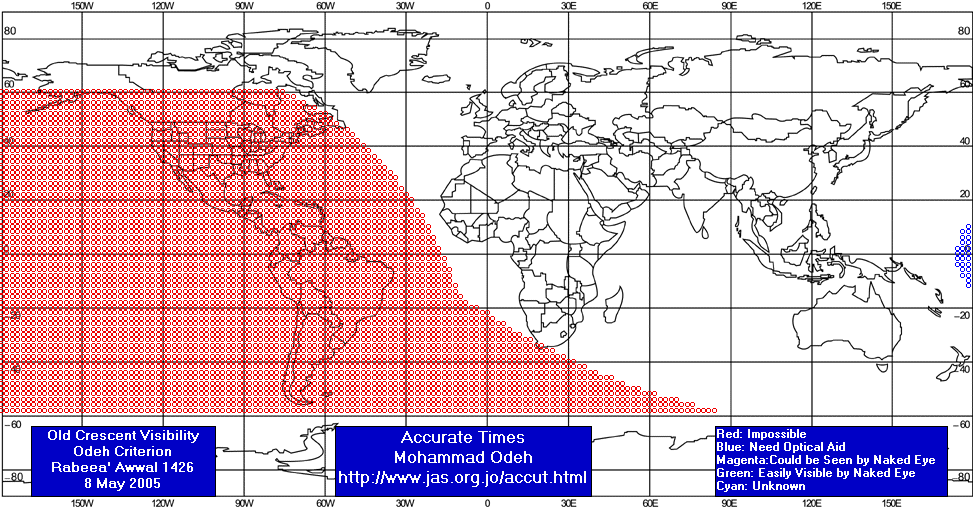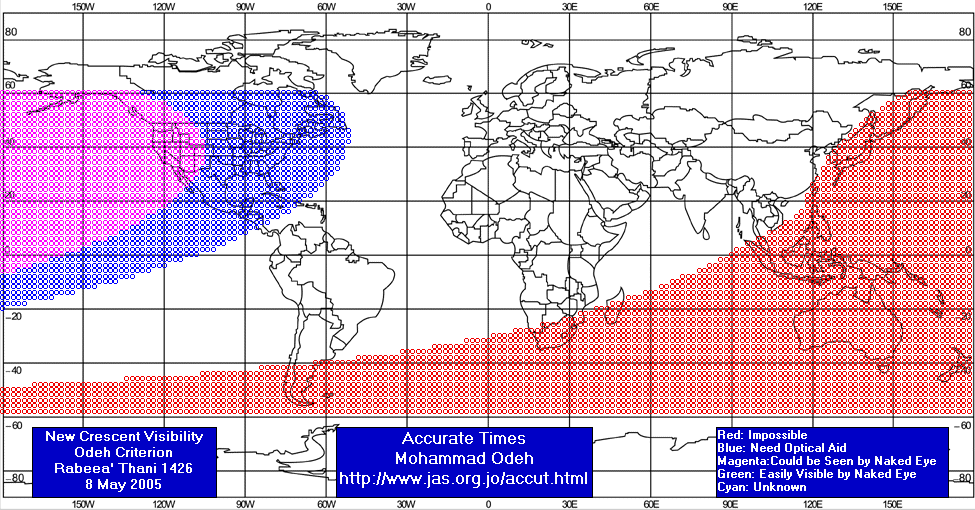Visibility of Rabee' Thani Crescent
(1426 AH)
- When to Observe Rabee' Awwal Waning (OLD) Crescent ?
- When to Observe Rabee' Thani Waxing (NEW) Crescent ?
- Rabee' Awwal Waning (OLD) Crescent Observation Results
- Rabee' Thani Waxing (NEW) Crescent Observation Results
- The OFFICIAL First Day in Different Countries
In Other Pages:-
- ICOP Main Page
- Members of ICOP (Individuals)
- Members of ICOP (Groups)
- Friends of ICOP
- ICOP Membership Application (For Individuals)
- ICOP Membership Application (For Groups)
- ICOP Observation Report Form
- ICOP Related Links
The geocentric conjunction of the new moon of Rabee'II 1426 will occur Inshallah on (Sunday 08 May 2005) at 08:45
UT. On that day, the software Accurate Times by Mohammad Odeh and according to Odeh criterion shows that it is impossible to see the waning (OLD) crescent from the western parts of the world, and it is not possible to see it from other parts of the world.
The geocentric conjunction of the new moon of Rabee'II 1426 will occur Inshallah on (Sunday 08 May 2005) at 08:45
UT. On that day, the software Accurate Times by Mohammad Odeh and according to Odeh criterion shows that the new crescent may only be visible by optical aid from the western and north western parts of the North American continent and parts of Canada; but should be easily visible from The Hawaii isles.
According to the actual sighting of the crescent, the start of Rabee' Thani should be on
Monday 09 May 2005 in some western parts of the world, or on Tuesday 10 May 2005 in the other parts of the world.
- Results of seeing the crescent, and the first day of the month in different countries will be added here Inshalla as we receive the reports from ICOP's members. If you wish to be a member in ICOP, or to know more about it, kindly click here.
So far, the earliest sighting of the crescent was on 08 May 2005 from USA by Mr. Don Pearce and Mr. Bill Flanagan.
Sunday 08 May 2005:
Sunday night, May 8th, presented an excellent opportunity to observe a “world class” first crescent Moon over much of North America.
The Texas Star Party ended on Saturday night and I thoroughly enjoyed the programs and camaraderie, but for the most part, the skies were persistently cloudy and disappointing. Then, late Saturday night, the skies began to clear, and upon wakening Sunday morning I saw some of the most pristine skies I had seen in a long time. It was if someone attending TSP had very bad karma, and his/her departure changed everything. Thanks to Bill Flanagan’s wireless internet connection, we were able to ascertain that fact on Saturday night, through locating the cloud cover/ transparency prediction models (Clear Sky Clock) indicating that the Davis Mountains region would likely be clear on Sunday night.
Earlier in the week we had scoped out the summit of Mt. Locke (elev.2054 m), the home of the Mc Donald Observatory, as a good location with a zero degree western horizon obstruction at the Sun/Moon setting azimuths.
One of holy grails of observing thin crescents is observing “opposing crescents” (the last old and first new on successive days). It is much more difficult than one might think. I remember that John Bortle, a veteran thin crescent observer, waited almost 20 years to accomplish the feat, and I waited 10 years to accomplish my record observation of opposing crescents on Jan. 27th-28th, 1998. This May offered an excellent chance to observe the May 7th old crescent and the May 8th new one, but, although I had scouted out a good location on the Prude Ranch for the morning event (near the summit of the hill on the western side of the football field), it was not to be as clouds prevented any attempt.
Bill and I arrived at the summit of Mt. Locke (N 30 40 17 W104 01 25) about a half hour before sunset on the 8th, and set up our equipment. Bill had a pair of 11x80 binoculars on a tripod, plus a camera. I had a pair of mounted 10x70 binoculars plus an 8-inch f 4.5 Newtonian with an eyepiece giving me 28x and 2.25 degree field. The Sun set at 8:39 pm, and the quest began in earnest.
One of the characteristics of the twilight sky is the frequent appearance of low, thin wispy clouds and the atmospheric pollution band hugging the horizon that is, at other times, invisible. Even though the daytime sky appeared absolutely pristine, these ever-present features became apparent only with the onset of twilight. I had carefully noted the position of Venus relative to the Moon long before the event, but as we began the hunt, for some reason I had forgotten about Venus. After about 10 minutes Bill swept up Venus in his binos, and then it all fell in place for me. At exactly 9:00 pm (CDT) I spotted the ulra-thin crescent in my 10X70 Fujinons, and Bill acquired the crescent at 9:06 pm in his binoculars. The illuminated arc was only about 60 degrees spanning from about 5-7 o’clock, and while it should have appeared slightly tilted to the left, I observed it as being straight up and down. There were times when it appeared slightly broken, and both of us also observed it in the 8-inch. In fact, we observed the tenuous crescent continuously, which I thought was unusual, until it became entirely invisible at 9:19 pm as it approached the horizon, just before moonset at 9:21 pm.
The age of the Moon at my first observation was 17 hrs. and 15 minutes, and for Bill,
17hrs.21 min., and while these are very young Moon observations, it is not anything close to
a timing “record”, but consider the following. When I first started observing thin crescents in
1988, the age factor was paramount, but since then it is generally recognized that the most
important factor is the solar-lunar elongation, since there can be a fairly wide variation in
times due to the varying speed of the Moon in its orbit, and other factors. Based on the
difficulty according to elongation, my observation and Bill’s rank, with elongations of 8?5’
and 8?8’ respectively, as, perhaps, the 4th and 5th most difficult binocular observations ever,
according to the Bradley Schaefer list in the February, 2004 Sky and Telescope article.
According to that list there were 3 telescopic observations more difficult, and it easily beat my own binocular record of 13 hrs.47 min. (8? 27’) set on May 5,1989. Oddly enough, it only barely beat Kenneth Drake’s binocular sighting of a thin crescent on March 10 of this year which was 8? 11’. Of course, none of these observations were seen naked eye as the naked eye record is 9?8’, set by Stephen O’Meara on May 24,1990.At this writing Bill has reported that the lunar image appears on the images we took with his camera.
Monday 09 May 2005:
Tuesday 10 May 2005 : -

When to Observe Rabee' Awwal Waning (OLD) Crescent ?


When to Observe Rabee' Thani Waxing (NEW) Crescent ?


Rabee' Awwal Waning (OLD) Crescent Observation Results

Rabee' Thani Waxing (NEW) Crescent Observation Results
Location = Tucson, Arizona (USA)
Longitude = 110.9645 W
Latitude = 32.4204 N
Elevation = 842 meters
Time Zone = -7.0 hour
Surface conditions at time of first sighting at
Tucson international Airport (805 m):
Temperature = 78 degrees Fahrenheit
Relative Humidity = 18 percent
Atmospheric Pressure = 1010 mb
Topocentric and local time values from “Accurate Times”:
Sunset (at sea level) = 19:15
Moonset (at sea level) = 20:00
Time from new moon at 17:21 = 17hr. 43min.
Moon lag time = 45 minutes
Relative Altitude = 8.4 degrees
Elongation from sun = 8.4 degrees
Crescent width = 10 arcseconds
Illumination = 0.54 percent
Crescent first observed through 8” SC telescope:
Time = 19:21
Altitude = 5 degrees
Final observation with telescope:
Time = 19:40
Altitude = 1 degrees
I was on the correct field for hours, but no crescent was visible, although I thought I saw something
in the correct location about a half hour before the crescent became visible. After the sun set and
it got darker, and I still could see no crescent, I thought that I was on the wrong field of view.
Just before I decided to begin sweeping, I saw the 30 degree image. A minute later, after centering
and focusing, the image was about 90 degrees in length. It kept the same appearance until it set.
Clouds prevented me from observing the old Moon yesterday.

The OFFICIAL First Day in Different Countries





